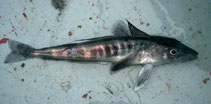Champsocephalus gunnari Lönnberg, 1905
Mackerel icefish
添加你自己的观测位置在 Fish Watcher
| Native range | All suitable habitat | Point map | Year 2050 |

|
| This map was computer-generated and has not yet been reviewed. |
| Champsocephalus gunnari AquaMaps Data sources: GBIF OBIS |
Common names from other countries
分类 / Names 俗名 | 同种异名 | Catalog of Fishes(属, 种) | ITIS | CoL | WoRMS | Cloffa
Teleostei > Perciformes/Notothenioidei (Icefishes) > Channichthyidae (Crocodile icefishes)
Etymology: Champsocephalus: Greek, champso = crocodile, voracious predator + Greek, kephale = head (Ref. 45335).
More on author: Lönnberg.
Etymology: Champsocephalus: Greek, champso = crocodile, voracious predator + Greek, kephale = head (Ref. 45335).
More on author: Lönnberg.
Environment: milieu / climate zone / depth range / distribution range 生态学
海洋 底中水层性; 深度上下限 0 - 700 m (Ref. 11892), usually 30 - 250 m (Ref. 11892). 極; 48°S - 66°S, 65°W - 77°E
分布 国家 | FAO区域 | 生态系 | 标本纪录 | Point map | 简介 | Faunafri
Southern Ocean: Islands of the Scotia Sea, including the northern part of Antarctic Peninsula; Kerguelen, Heard and Bouvet islands.
南極海: Scotia 海洋的島, 包括南極半島的北部; 被聽到的 Kerguelen 與布威島; 在大西洋南方部, 在南喬治亞州的附近。 也在奧克尼群島南方部與雪特蘭群島南部的附近。
南極海: Scotia 海洋的島, 包括南極半島的北部; 被聽到的 Kerguelen 與布威島; 在大西洋南方部, 在南喬治亞州的附近。 也在奧克尼群島南方部與雪特蘭群島南部的附近。
Length at first maturity / 大小 / 重量 / 年龄
Maturity: Lm 26.2, range 21 - 32 cm
Max length : 66.0 cm TL 雄鱼/尚未辨别雌雄; (Ref. 5200); common length : 35.0 cm TL 雄鱼/尚未辨别雌雄; (Ref. 2805); 最大体重: 2.0 kg (Ref. 4883)
Max length : 66.0 cm TL 雄鱼/尚未辨别雌雄; (Ref. 5200); common length : 35.0 cm TL 雄鱼/尚未辨别雌雄; (Ref. 2805); 最大体重: 2.0 kg (Ref. 4883)
简单描述 检索表 | 型态特徵 | 形态测量图
脊椎骨: 59 - 62.
Feed mainly on krill and mysids. Spawn in autumn and winter (Ref. 50743). Synchronous spawner (Ref. 50743). Larval pelagic phase is long (Ref. 71843). Utilized as a food fish (Ref. 4931).
主要捕食磷虾与糠虾。 产卵于秋天与冬天中。 (参考文献 50743) 同步的产卵鱼.(参考文献 50743) 作为食用鱼.(参考文献 4931)
主要捕食磷虾与糠虾。 产卵于秋天与冬天中。 (参考文献 50743) 同步的产卵鱼.(参考文献 50743) 作为食用鱼.(参考文献 4931)
Life cycle and mating behavior 成熟度 | 繁殖 | 产卵场 | 卵 | 孕卵数 | 仔鱼
南極海: Scotia 海洋的島, 包括南極半島的北部; 被聽到的 Kerguelen 與布威島; 在大西洋南方部, 在南喬治亞州的附近。 也在奧克尼群島南方部與雪特蘭群島南部的附近。
主要参考文献
Upload your references | 参考文献 | 合作者 | 合作者
Hureau, J.-C., 1985. Channichthyidae. p. 261-277. In W. Fischer and J.C. Hureau (eds.) FAO species identification sheets for fishery purposes. Southern Ocean (Fishing areas 48, 58 and 88). Rome. Vol. 2. (Ref. 2805)
对人类的威胁
无害处的
人类利用
渔业: 低经济
FAO(渔业: 产生; publication : search) | FIRMS (Stock assessments) | FishSource | 周边海洋
更多信息
Population dynamics
成长参数
Max. ages / sizes
Length-weight rel.
Length-length rel.
体长-频率
Mass conversion
入添量
丰度
成长参数
Max. ages / sizes
Length-weight rel.
Length-length rel.
体长-频率
Mass conversion
入添量
丰度
Physiology
Body composition
Nutrients
耗氧量
游泳类型
游泳速度
Visual pigments
Fish sound
Diseases & Parasites
Toxicity (LC50s)
Body composition
Nutrients
耗氧量
游泳类型
游泳速度
Visual pigments
Fish sound
Diseases & Parasites
Toxicity (LC50s)
工具
E-book | 野外调查 | 检索表 | 长度- 频率 Wizard | 生活- 历史的工具 | 分布图 | Classification Tree
| Catch-MSY |
特别资料
下载 XML
网络资源
Aquatic Commons | BHL | Cloffa | BOLDSystems | Websites from users | 核实 FishWatcher | CISTI | Catalog of Fishes(属, 种) | DiscoverLife | ECOTOX | Faunafri | Fishtrace | GenBank(基因组, 核苷酸) | GloBI | GOBASE | | Google Books | Google Scholar | Google | IGFA World Record | MitoFish | Otolith Atlas of Taiwan Fishes | PubMed | Reef Life Survey | Scirus | SeaLifeBase | 树状分类阶层 | Wikipedia(转至, 搜寻) | World Records Freshwater Fishing | Zoobank | 动物学的记录
Estimates based on models
Preferred temperature (Ref. 115969): -1.1 - 2.9, mean 1.5 (based on 50 cells).
Phylogenetic diversity index (Ref. 82804): PD50 = 0.7500 [Uniqueness, from 0.5 = low to 2.0 = high].
Bayesian length-weight: a=0.00120 (0.00102 - 0.00142), b=3.47 (3.42 - 3.52), in cm Total Length, based on LWR estimates for this species (Ref. 93245).
营养阶层 (Ref. 69278): 3.2 ±0.2 se; based on diet studies.
回复力 (Ref. 120179): 中等的, 族群倍增时间最少 1.4 - 4.4年 (K=0.13-0.39; tmax=13; tm=4; Fec=3,094).
Prior r = 0.39, 95% CL = 0.26 - 0.59, Based on 2 data-limited stock assessments.
Fishing Vulnerability (Ref. 59153): Moderate vulnerability (35 of 100).
Climate Vulnerability (Ref. 125649): High to very high vulnerability (68 of 100).




